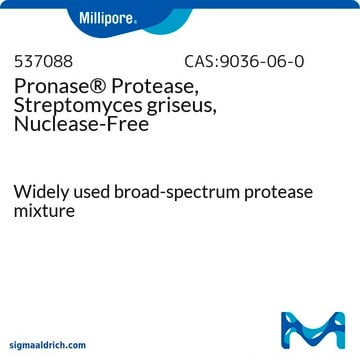Recommended Products
biological source
Streptomyces griseus
form
fine powder
manufacturer/tradename
Calbiochem®
storage condition
OK to freeze
color
slightly brown
shipped in
ambient
storage temp.
2-8°C
General description
Pronase E is obtained from the extracellular fluid of Streptomyces griseus. It is made up of several proteases and peptidases.
Biochem/physiol Actions
Pronase E participates in the hydrolysis of peptide bonds internal to a sequence and sequentially eliminates amino acids from the N- and C-termini. This enzyme is the preferred alternative for enzymatic digestion with trypsin or chymotrypsin.
Legal Information
CALBIOCHEM is a registered trademark of Merck KGaA, Darmstadt, Germany
Signal Word
Danger
Hazard Statements
Precautionary Statements
Hazard Classifications
Eye Irrit. 2 - Resp. Sens. 1 - Skin Irrit. 2 - STOT SE 3
Target Organs
Respiratory system
Storage Class Code
11 - Combustible Solids
WGK
WGK 2
Certificates of Analysis (COA)
Search for Certificates of Analysis (COA) by entering the products Lot/Batch Number. Lot and Batch Numbers can be found on a product’s label following the words ‘Lot’ or ‘Batch’.
Already Own This Product?
Find documentation for the products that you have recently purchased in the Document Library.
Customers Also Viewed
Emilie R Mainz et al.
Analytical chemistry, 87(15), 7987-7995 (2015-07-15)
The ability to track intracellular peptide proteolysis at the single cell level is of growing interest, particularly as short peptide sequences continue to play important roles as biosensors, therapeutics, and endogenous participants in antigen processing and intracellular signaling. We describe
Angela Proctor et al.
Methods in enzymology, 622, 221-248 (2019-06-04)
Chemical cytometry, sensitive analytical measurements of single cells, reveals inherent heterogeneity of cells within a population which is masked or averaged out when using bulk analysis techniques. A particular challenge of chemical cytometry is the development of a suitable reporter
Our team of scientists has experience in all areas of research including Life Science, Material Science, Chemical Synthesis, Chromatography, Analytical and many others.
Contact Technical Service

















